Intervention program with mobile app cuts 2nd suicide attempts by 48%
An inpatient suicide intervention program, coupled with a personalized app that offers recovery strategies for distressed suicidal patients, reduced attempted suicides by almost half, according to a new study published in the American Journal of Psychiatry.
The As Safe as Possible (ASAP) intervention program involves a brief therapy session, where providers offer various coping strategies to at-risk teenagers. Providers learn more about a patient’s favorite activities and fond memories, which are then programmed into the personalized BRITE application. The BRITE app prompts users to rate their mood and offers personalized recovery strategies.
The study, led by Betsy Kennard, PsyD, of UT Southwestern in Dallas, tracked 66 patients aged 12-18 who were hospitalized after attempting or contemplating suicide.
They found nearly a third—31 percent—of the cohort who received standard care attempted suicide again within 24 weeks of hospital discharge. Only 16 percent of the adolescents who completed the intervention program and utilized the application attempted suicide in that same time frame—a decrease of 48 percent in the small cohort.
"Those first few weeks between leaving the hospital and receiving outpatient care is a high-risk time for these adolescents," Kennard said in a UT Southwestern-issued statement. "We're trying to equip them with the tools they need when they become distressed—skills that may not be taught during standard inpatient treatment because there's so much that goes into just stabilizing patients during their few days in the hospital."
Kennard and colleagues believe the present results are positive. They also plan to initiate the same study with a larger cohort to assess the efficacy of their program.
"This approach merits further study," she said. "Focusing on stress tolerance and giving access to positive emotion could be a lifesaving difference for so many patients."

